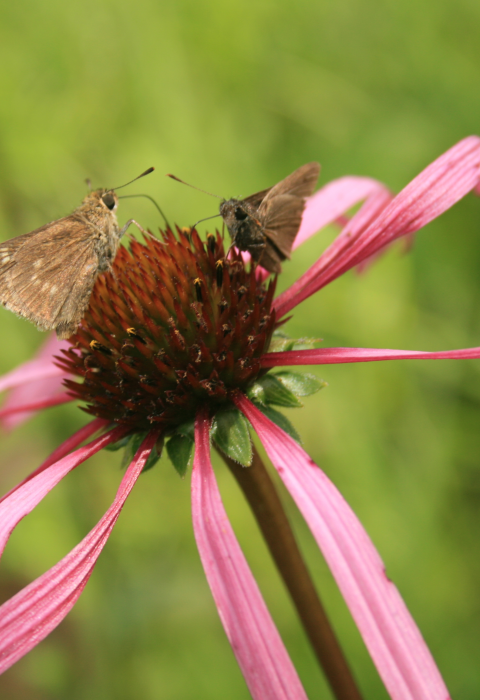The U.S. Fish and Wildlife Service is reclassifying the smooth coneflower from endangered to threatened under the Endangered Species Act (ESA). The Service is also finalizing a 4(d) rule that tailors protections and allows greater flexibility for management actions that will benefit the plant. The proposal represents a significant recovery milestone for the plant following years of ESA-inspired partnerships across its range in Georgia, North Carolina, South Carolina and Virginia.
The ESA defines endangered as a species that is currently in danger of extinction throughout all or a significant portion of its range and threatened as a species that is likely to become endangered in the foreseeable future. Downlisting this plant speaks to the power of conservation partnerships between federal, state and private stakeholders under the ESA.
“Our partners have done an amazing job at reducing threats to this plant which is helping pave the way to its recovery,” said Leopoldo Miranda-Castro, the Service’s Regional Director. “We now need to ensure management for all protected, resilient populations of smooth coneflower continue into the future. Once we do that, the species could be considered for delisting,” added Miranda-Castro.
Assessing the Smooth coneflower’s status was pivotal to move forward with a proposal to downlist the plant. Land managers that have smooth coneflower populations contributed greatly to this final downlisting. When the Service listed the plant as an endangered species in 1992, 39 populations had disappeared, and the 21 remaining populations were vulnerable and unstable. Since then, more populations have been discovered and conservation projects have been implemented with documented success. The Service has also funded research projects that have led to increased knowledge about the coneflower’s genetics, pollination ecology, and creation of seed banks.
Today, 44 distinct populations of smooth coneflower exist in Virginia (15), North Carolina (6), South Carolina (12) and Georgia (11). Sixteen of these 44 populations are considered healthy and occur within protected national forests and nature preserves where threats from habitat modification have been reduced.
When the coneflower was listed, the primary threats to it were fire suppression, development, invasive species invasive species
An invasive species is any plant or animal that has spread or been introduced into a new area where they are, or could, cause harm to the environment, economy, or human, animal, or plant health. Their unwelcome presence can destroy ecosystems and cost millions of dollars.
Learn more about invasive species and highway right-of-way maintenance activities such as pesticide application and mowing. Some threats still remain, including habitat loss, degradation, fragmentation and the effects of climate change climate change
Climate change includes both global warming driven by human-induced emissions of greenhouse gases and the resulting large-scale shifts in weather patterns. Though there have been previous periods of climatic change, since the mid-20th century humans have had an unprecedented impact on Earth's climate system and caused change on a global scale.
Learn more about climate change , such as drought, which can be especially detrimental during the growing season.
The U.S. Forest Service manages smooth coneflower habitat within Chattahoochee National Forest, Sumter National Forest, George Washington and Jefferson National Forests, as well as at the Savannah River Site. Since its listing, the U.S. Forest Service has designated Special Management Areas for each of their populations, thereby limiting access to the plants. They use prescribed fire to maintain suitable habitat, helping ensure smooth coneflower populations thrive.
In addition to the U.S. Forest Service, other organizations collaborating on smooth coneflower conservation include the North Carolina Botanical Garden, North Carolina Plant Conservation Program, the State Botanical Garden of Georgia, the Atlanta Botanical Garden, the Georgia Plant Conservation Alliance, U.S. Army Corps of Engineers, county governments, and numerous other partners. These groups monitor coneflower populations on a regular basis and also plant smooth coneflower to augment existing populations. Prescribed fire is used to reduce competition from woody species, eradicate invasive species, and promote smooth coneflower germination and growth.
The Service published a proposal to downlist smooth coneflower on June 23, 2021 and made it available for public comment. Service efforts with partners to strategically plan and implement collaborative conservation for smooth coneflower will continue until recovery is achieved. Smooth coneflower conservation is representative of the principles within the America the Beautiful initiative grounded in the use of science as a guide to sustain imperiled animals, plants and their habitats for the enjoyment by current and future generations.
Find out more about this plant at: https://www.fws.gov/southeast/wildlife/plants/smooth-coneflower
The mission of the U.S. Fish and Wildlife Service is working with others to conserve, protect, and enhance fish, wildlife, plants, and their habitats for the continuing benefit of the American people. For more information on our work and the people who make it happen, visit www.fws.gov. Connect with our Facebook page atwww.facebook.com/usfwssoutheast, follow our tweets at www.twitter.com/usfwssoutheast, watch our YouTube Channel at http://www.youtube.com/usfws and download photos from our Flickr page at http://www.flickr.com/photos/usfwssoutheast.



